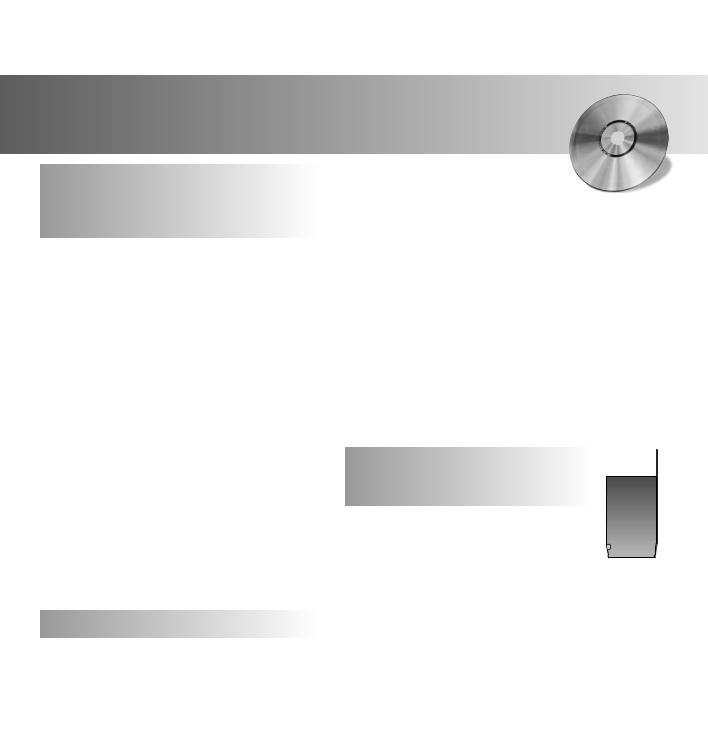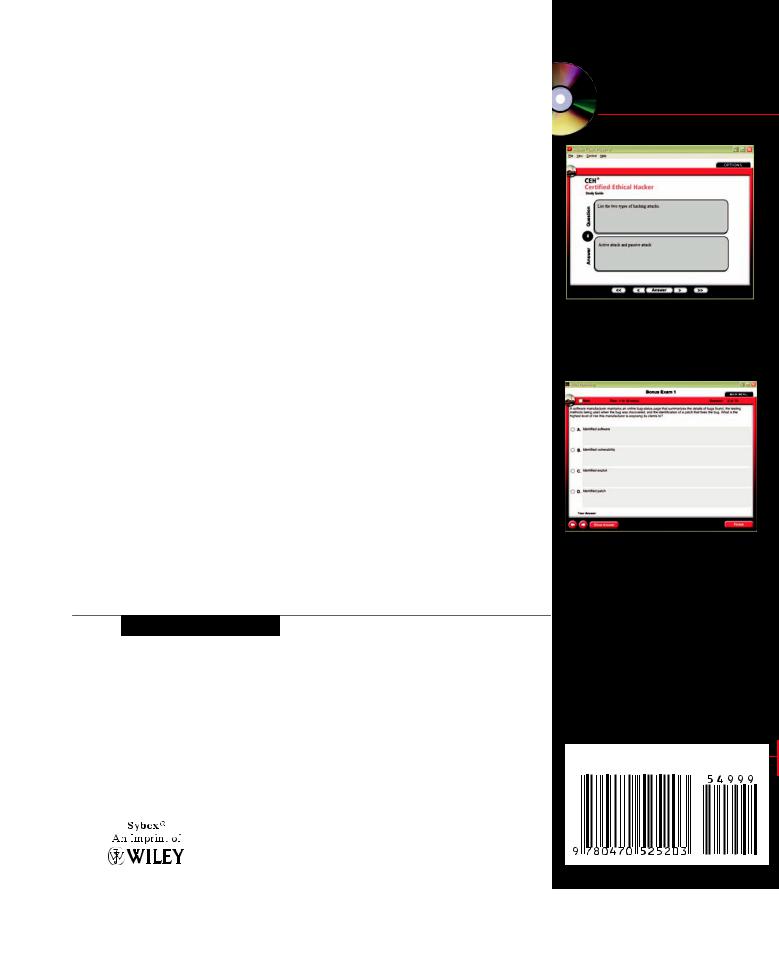
- •Acknowledgments
- •About the Author
- •Contents at a Glance
- •Contents
- •Table of Exercises
- •Introduction
- •Assessment Test
- •Answers to Assessment Test
- •Defining Ethical Hacking
- •How to Be Ethical
- •Keeping It Legal
- •Summary
- •Exam Essentials
- •Review Questions
- •Answers to Review Questions
- •Reconnaissance
- •Information-Gathering Methodology
- •Social Engineering
- •Summary
- •Exam Essentials
- •Review Questions
- •Answers to Review Questions
- •Scanning
- •Enumeration
- •Summary
- •Exam Essentials
- •Review Questions
- •Answers to Review Questions
- •The Simplest Way to Get a Password
- •Types of Passwords
- •Cracking a Password
- •Understanding Keyloggers and Other Spyware Technologies
- •Escalating Privileges
- •Understanding Rootkits
- •Hiding Files
- •Understanding Steganography Technologies
- •Summary
- •Exam Essentials
- •Review Questions
- •Answers to Review Questions
- •Trojans and Backdoors
- •Viruses and Worms
- •Summary
- •Exam Essentials
- •Review Questions
- •Answers to Review Questions
- •How a Sniffer Works
- •Sniffing Countermeasures
- •Bypassing the Limitations of Switches
- •Wireshark Filters
- •Summary
- •Exam Essentials
- •Review Questions
- •Answers to Review Questions
- •Denial of Service
- •Session Hijacking
- •Summary
- •Exam Essentials
- •Review Questions
- •Answers to Review Questions
- •How Web Servers Work
- •Types of Web Server Vulnerabilities
- •Web Application Vulnerabilities
- •Summary
- •Exam Essentials
- •Review Questions
- •Answers to Review Questions
- •SQL Injection
- •Buffer Overflows
- •Summary
- •Exam Essentials
- •Review Questions
- •Answers to Review Questions
- •Wi-Fi and Ethernet
- •Authentication and Cracking Techniques
- •Using Wireless Sniffers to Locate SSIDs
- •MAC Filters and MAC Spoofing
- •Rogue Access Points
- •Wireless Hacking Techniques
- •Securing Wireless Networks
- •Summary
- •Exam Essentials
- •Review Questions
- •Answers to Review Questions
- •Components of Physical Security
- •Understanding Physical Security
- •Physical Site Security Countermeasures
- •What to Do After a Security Breach Occurs
- •Summary
- •Exam Essentials
- •Review Questions
- •Answers to Review Questions
- •Linux Basics
- •Compiling a Linux Kernel
- •GCC Compilation Commands
- •Installing Linux Kernel Modules
- •Linux Hardening Methods
- •Summary
- •Exam Essentials
- •Review Questions
- •Answers to Review Questions
- •Types of IDSs and Evasion Techniques
- •Summary
- •Exam Essentials
- •Review Questions
- •Answers to Review Questions
- •Generating Public and Private Keys
- •Cryptography Algorithms
- •Summary
- •Exam Essentials
- •Review Questions
- •Answers to Review Questions
- •Defining Security Assessments
- •Penetration Testing
- •Pen Test Deliverables
- •Summary
- •Exam Essentials
- •Review Questions
- •Answers to Review Questions
- •Glossary
- •Index

Index
Note to the Reader: Throughout this index boldfaced page numbers indicate primary discussions of a topic. Italicized page numbers indicate illustrations.
A
A (Address) records, 46 access points (AP)
finding, 248 rogue, 250–251
ACK bit
TCP Headers, 157
three-way handshakes, 74, 74 ACK scans, 71
AckCmd program, 315 active attacks, 13
password, 98–99 session hijacking, 183 stack fingerprinting, 78
Active Directory
DNS servers for, 85 viruses, 142
Active Directory Administration Tool (ldp. exe), 85
active reconnaissance phase in hacking, 8 active sniffing, 158
Acunetix Web Vulnerability Scanner, 211–212,
211–212
Additional Restrictions For Anonymous Connections option, 85
Address (A) records, 46 address ranges for networks, 46
Address Resolution Protocol (ARP) attacks, 158
countermeasures, 160, 160 operation, 159
poisoning, 159 spoofing, 164–165
addresses
IP. See IP addresses
MAC. See MAC (Media Access Control) addresses
Admin$ share, 98
administrator passwords and usernames, 252 ADMmutate tool, 304
Advanced Encryption Standard (AES), 243 Aircrack tool, 243, 245
AirSnort tool, 243, 245 alarm systems
auditing, 273 motion-sensing, 267
alternate data streams, 113–114 American Registry for Internet Numbers
(ARIN), 40, 43, 43, 46 Angry IP Scanner tool, 76 anonymizers, 80, 80 anonymous scanning, 79–81, 80 Anonymouse, 80, 80
anti-honeypot software, 314–315 Anti-spector tool, 109 Antichrist virus hoax, 143 antivirus definitions, 134
AP Masquerading, 250–251
APNIC (Asia Pacific Network Information Centre), 44
application attacks, 221–222
buffer overflows. See buffer overflows exam essentials, 232
review questions, 233–237
SQL injection. See SQL injection summary, 232
application-level rootkits, 112 applications
executing, 111 exploiting, 11
web server bugs, 198
APR (ARP Poison Routing), 165–166 APs (access points)
finding, 248 rogue, 250–251
ARIN (American Registry for Internet Numbers), 40, 43, 43, 46
armored viruses, 142
ARP (Address Resolution Protocol) attacks, 158
countermeasures, 160, 160 operation, 159
poisoning, 159 spoofing, 164–165
ARP Poison Routing (APR), 165–166

376 arpspoof tool – cache command in Google
arpspoof tool, 138, 165 art of manipulation, 50
Asia Pacific Network Information Centre (APNIC), 44
asymmetric key encryption, 326–328 Atbash ciphers, 325, 325
attack phase
DDoS attacks, 178 penetration tests, 347
attacks, defined, 7 attrib command, 113 Auditpol tool, 117 audits, 344
disabling, 116–117 physical security, 269–273
authentication attacks on, 6
in CIA triad, 325 hijacking, 210 Linux, 291
SQL injection, 225 two-factor, 99 web, 212–213
wireless networks, 242–245, 244, 251 automated password guessing, 98–99 automated tools
network-tracing, 182 penetration tests, 349–350
B
backdoors installing, 111
overview, 125–127 rootkits, 112
BackOrifice tool, 127, 131 BackStealth tool, 81 backups, securing, 268
badges for employees and contractors, 268 banner grabbing techniques, 77–79, 79,
201–202
bash (Bourne Again Shell), 283
basic authentication types for web, 212 Beast Trojan, 132
biometric authentication, 99, 213 bit-flipping attacks, 6
black-box testing, 13
black hats, 3 overview, 4
penetration tests, 345
BlackWidow tool, 200, 200–201, 206, 211 Blindside application, 115
block ciphers, 328–329, 329 blogs as information source, 40 Blowfish cipher, 336
BoSniffer tool, 131 BOTs/BOTNETs
DDoS attacks, 178, 179 operation, 179, 180
Bourne Again Shell (bash), 283 Bourne Shell, 283
breaches of physical security, 274 brute-force attacks
cryptography, 337 description, 100 web passwords, 213
Brutus password cracker, 213–214, 214 Bubonic tool, 176
Budweiser Frogs virus hoax, 143 buffer overflows, 11, 229
countermeasures, 231–232 description, 111
exam essentials, 232 IIS attacks, 206
review questions, 233–237 summary, 232
types and detection methods, 229–231, 230 web applications, 210
Burp tool, 211
bypassing network security, 301 exam essentials, 316
firewall types and honeypots, 308–315,
309, 311–314
IDS evasion techniques, 302–307, 303 review questions, 317–322
Snort sniffer, 304–307 summary, 316
C
C$ share, 98 C:\Windows share, 98
C2MYAZZ program, 105–106 cache command in Google, 39

Cain & Abel tool – defacing websites |
377 |
Cain & Abel tool, 166 CameraShy tool, 115 camouflage viruses, 142
Canonical Name (CNAME) records, 46 Canvas tool, 350
case locks, 267 cavity viruses, 142
certificate authorities (CAs), 330–331, 330 certificates
encryption, 328
viewing, 331–333, 332–333 web authentication, 213
change interval for passwords, 108 Checksum field in TCP Headers, 157 Cheops management tool, 78 chosen-cipher text attacks, 337 chosen-plain text attacks, 337
CIA triad, 325, 325
CIFS (Common Internet File System), 82–83 cipher text, 324, 324
cipher text-only attacks, 336 ciphers
block and stream, 328–329, 329 historical, 325–326, 325–326
clearing logs, 116–117 cleartext, 324, 324 cloaking websites, 200
CNAME (Canonical Name) records, 46 command injection, 210
Common Internet File System (CIFS), 82–83 common port numbers, 65–66
community strings, 84
competitive intelligence, 34–37, 35–36 compilation
GNU commands, 288
Linux kernel, 285–288, 286, 288 computer-based social engineering, 50–53 computer crimes, 19
ComputerSpy Key Logger program, 131 concealment ciphers, 326
conclusion phase of penetration tests, 18 conduct security evaluation phase of
penetration tests, 18 confidentiality attacks, 6 confidentiality in CIA triad, 325 contractors, badges for, 268
Control Bits field in TCP Headers, 157
control frames in MAC Headers, 241 cookies
poisoning and snooping, 210 for SYN attacks, 180–181
copying websites, 200, 200–201 CORE IMPACT tool, 208, 347, 349 Cottrell, Lance, 80
covering tracks, 10–11, 116–117 covert channels, 128–130 Covert_TCP program, 315 CPUHog tool, 176
crackers defined, 3 overview, 4
“Crimes and Criminal Procedure” section, 20 cross-site scripting, 210
cryptography, 323 algorithms, 335–336, 336 attacks, 337
encryption, 324–329, 324–326, 329 exam essentials, 338
key generation, 329–335, 330, 332–334 review questions, 339–342
summary, 337
Cyber Security Enhancement Act, 19 CyberSpy Trojan, 132
D
daemons, 177
data extraction in SQL injection, 225 data frames in MAC Headers, 241 Data Offset field in TCP Headers, 157 data-sending Trojans, 130
database schema in SQL injection, 225 DCOM (Distributed Component Object
Mode), 111
DDoS (distributed denial-of-service) attacks BOTs/BOTNETs, 179, 180
process, 177–178, 178–179 decoy systems, 308–310, 309
countermeasures, 315 finding, 310
installing, 310–315, 311–314 Deep Throat Trojan, 127 defacing websites, 202

378 defaults – eMailTrackerPro tool
defaults
administrator passwords and usernames, 252
Linux systems, 293 port numbers, 127 SSIDs, 253
websites, disabling, 199–200, 199 deliverables in penetration tests, 350–351, 351 demilitarized zones (DMZs), 198,
308–309, 345 denial-of-service (DoS) attacks, 173
countermeasures, 182 description, 5
distributed, 177–179, 178–180 exam essentials, 188 NetBIOS, 107
overview, 174–177
review questions, 189–194
Smurf and SYN floods, 180–181, 181 SQL injection, 225
summary, 187 Trojans, 130 wireless, 251
Denton, Jeremiah, 129
deny all users access in Linux, 289 Department of Veterans Affairs laptop
theft, 265 DEPLOY.EXE program, 112
destination port number in TCP Headers, 157 destructive Trojans, 130
desynchronizing connections, 183 diagrams for networks, 78 dictionary attacks, 100, 213 Dictionary Generator tool, 98 digest authentication types, 212 digital certificates
encryption, 328
viewing, 331–333, 332–333 web authentication, 213
digital signatures. See signatures directories in Linux, 283–284 directory-traversal attacks, 205, 210 disabling
auditing, 116–117
default websites, 199–200, 199 removable media drives, 268
Distributed Component Object Mode (DCOM), 111
distributed denial-of-service (DDoS) attacks BOTs/BOTNETs, 179, 180
process, 177–178, 178–179 Distributed DNS Flooder tool, 166 distributions, Linux, 282
DMZs (demilitarized zones), 198, 308–309, 345
DNS. See domain name system (DNS) dnsspoof tool, 138, 165
DNSstuff tool, 40–41, 41 Domain controllers, 85 domain name system (DNS)
enumeration, 40–45, 41–43 records, 46
spoofing, 164–166 zone transfer, 85–86 Donald Dick Trojan, 131
doors, auditing, 271
DoS attacks. See denial-of-service (DoS) attacks
Dskprobe tool, 116 Dsniff tools, 138, 165 DumpSec tool, 82 dumpster diving, 51, 102
dynamic strings in SQL injection, 226–228,
227–228
E
E mail Keylogger, 110
EAP (Extensible Authentication Protocol) standards, 243
eavesdropping, 97, 251. See also sniffers eBlaster spyware, 109
EDGAR database, 36–37, 36 editors in Linux, 282
802.11 networks, 241–244, 241, 244 ELiTeWrap wrapper, 135
elsave.exe utility, 117 emails
tracking, 48 virus hoaxes, 143
eMailTrackerPro tool, 48

employees – fingerprinting techniques |
379 |
employees
badges for, 268 impersonating, 50
encryption, 323. See also cryptography algorithms, 325
block ciphers and stream ciphers,
328–329, 329
key generation, 329–335, 330, 332–334 passwords, 97, 102
techniques, 324–326, 324–326 types, 326–328
uses, 333–335, 334
wireless networks, 242–243, 251, 253 Enum utility, 86
enumeration, 81–82
DNS, 40–45, 41–43 exam essentials, 87–88 null sessions, 82–84 review questions, 89–93
SNMP, 84–85 summary, 86
Windows 2000 DNS zone transfer, 85–86 equipment theft, 263
erasing evidence, 116–117 escalating privileges, 110–111
penetration tests, 347 SQL injection, 226
Ethereal tool, 161 EtherFlood tool, 165
Ethernet networks, 240–242, 241 EtherPeek sniffer, 161
ethical hacking overview, 1 actions, 5
black hats, 4 definition, 2–3
exam essentials, 23–24 gray hats, 4–5
hacker goals, 5–6 hacker skill sets, 6 legal issues, 18–23 penetration tests, 17–18 phases, 8–11, 8 reports, 16
review questions, 25–29
security, functionality, and ease of use triangle, 14–15, 14
steps, 16–18, 17 summary, 23 technologies, 11 terminology, 7–8 tests, 13–14, 14 types, 12–13
vulnerability research and tools, 15 white hats, 4
Event Viewer logs clearing, 116–117 monitoring, 108–109
evidence, erasing, 116–117 Evidence Eliminator system, 117 Evil Twin attacks, 250
exclusive OR (XOR) operation for stream ciphers, 329, 329
executing applications, 111
executing, implanting, and retracting phase in penetration tests, 347
exploits, 7–8
Extensible Authentication Protocol (EAP) standards, 243
exterior area audits, 270–271 external assessment tests, 345
F
fast infectors, 142
Fearless Key Logger Trojan, 110
Federal Managers Financial Integrity Act (FMFIA), 20–21
files
hiding, 113–116
Linux, 283, 290 filesnarf tool, 165
filetype command in Google, 39 filtered ports, 70
filters
MAC, 6, 248–249, 249 network-ingress, 182 Wireshark, 161–164, 162–164
FIN scans, 73–74 Find_ddos tool, 182 fingerprinting techniques
OS, 77–79, 79
SQL injection, 225

380 Firekiller 2000 tool – host-auditing tools
Firekiller 2000 tool, 132 firewalls
ping sweeps, 68 for sniffers, 159 traceroute with, 46
types, 308–315, 309, 311–314 wireless settings, 253
flag types in TCP, 73–76, 74, 76 floods
MAC, 164–166 SYN, 180–181, 181
FMFIA (Federal Managers Financial Integrity Act), 20–21
FMS (Fluhrer, Mantin, and Shamir) attacks, 243
FoIA (Freedom of Information Act), 21 footprinting, 33
targets, 39 tools, 38–39
traceroute in, 46–47, 47 FOR command, 99
Fport tool, 137 frames
capturing. See sniffers defined, 154
“Fraud and related activity in connection with access devices” section, 20
“Fraud and related activity in connection with computers” section, 20
Freedom of Information Act (FoIA), 21 freeware tools, 137
Friendly Pinger tool, 69 FTP Trojans, 130
Fyodor penetration tests list, 349
G
gaining access phase in hacking, 10 gathering information. See information
gathering
GCC (GNU Compiler Collection), 288 GetAcct tool, 86
GetAdmin.exe program, 110 GFI LANguard scanner, 349 GirlFriend Trojan, 127 Global Catalog service, 85
GNU Compiler Collection (GCC), 288
goals, hacker, 5–6 Goodtimes virus, 143 Google
hacking, 211–212, 211–212
for information gathering, 39–40 Google Groups, 37
Government Paperwork Elimination Act (GPEA), 22
Graffiti game, 135
graphic images as hiding places, 115–116 gray-box testing, 13
gray hats, 3–5
Group Policy security, 85 guessing passwords, 98–99
H
hacktivism, 18 half-open scanning, 71
handshakes, three-way, 73–74, 74, 183–184 Hard Drive Killer Pro programs, 132 hardening methods, 10
Linux, 289–292, 292 web servers, 208–209
Harris Stat management tool, 78 Hashed Message Authentication Code
(HMAC), 336 hashes
dictionary words, 100 passwords, 97, 102 WinMD5 for, 333–335, 334
heap in buffer overflows, 229–230
help desks in social engineering attacks, 51 hiding files, 113–116
HIDSs (host-based IDSs), 302 hijacking, session. See session hijacking Hk.exe utility, 110
HMAC (Hashed Message Authentication Code), 336
hoaxes, viruses, 143–145
home wireless network security, 252–254 Honeyd honeypot, 315
honeypots, 308–310, 309 countermeasures, 315 finding, 310
installing, 310–315, 311–314 host-auditing tools, 182

host-based IDSs (HIDSs) – Internet Protocol Security (IPSec) |
381 |
host-based IDSs (HIDSs), 302 host-to-host network communications,
154–157, 155–156 hping2 tool, 75
HTTP (Hypertext Transfer Protocol) authentication, 212–213 components, 197, 197
tunneling tools, 80–81 HTTPort tool, 81
HTTPS (Hypertext Transfer Protocol Secure), 197
HTTrack tool, 78
human-based social engineering, 50–51 Hunt program, 185
hybrid attacks description, 100 web passwords, 213
Hyena tool, 82
Hypertext Transfer Protocol (HTTP) authentication, 212–213 components, 197, 197
tunneling tools, 80–81 Hypertext Transfer Protocol Secure
(HTTPS), 197
I
IANA (Internet Assigned Numbers Authority), 46
ICANN (Internet Corporation for Assigned Names and Numbers), 42
ICMP (Internet Control Message Protocol) scanning, 68
shell access, 130 for traceroute, 46 tunneling, 129
ICMP Shell program, 315 Icmpenum tool, 75
Icon Converter Plus program, 135 identity theft, 52
IDLE scans, 73
IDSs (intrusion detection systems), 66 for DoS attacks, 182
Snort, 161
types, 302–303, 303
IIS (Internet Information Server) hacking,
205–206
IKS (Invisible KeyLogger Stealth) Software Logger, 110
ImageHide program, 115–116 impersonation, 50
information gathering, 9, 31–32 enumeration. See enumeration exam essentials, 55 methodology, 37, 37
DNS enumeration, 40–45, 41–43 DNS records, 46
email tracking, 48 footprinting, 38–39 Google, 39–40
network address range, 46 traceroute, 46–47, 47 web spiders, 48
Whois and ARIN lookups, 42–45, 42–43 reconnaissance, 33–37, 35–36
review questions, 56–60 scanning. See scanning sniffers. See sniffers social engineering, 48–54 summary, 54
information theft, 6 injection
packets, 183
SQL. See SQL injection inside attacks, 14, 52, 263 Instant Source tool, 210 integrity attacks, 6 integrity in CIA triad, 325
Inter-Process Communication share (IPC$), 83 internal assessment tests, 345
Internet Assigned Numbers Authority (IANA), 46
Internet Control Message Protocol (ICMP) scanning, 68
shell access, 130 for traceroute, 46 tunneling, 129
Internet Corporation for Assigned Names and Numbers (ICANN), 42
Internet Information Server (IIS) hacking,
205–206
Internet Protocol Security (IPSec), 186

382 InternetServerApplicationProgrammingInterface(ISAPI)extensions – legalissues
Internet Server Application Programming Interface (ISAPI) extensions, 205
Internet spoofing, 165
intitle command in Google, 39 Intranet spoofing, 165
intrusion detection systems (IDSs), 66 for DoS attacks, 182
Snort, 161
types, 302–303, 303
intrusion phase in DDoS attacks, 178 intrusion prevention systems (IPSs), 302 inurl command in Google, 39–40 Invisible KeyLogger Stealth (IKS) Software
Logger, 110
invitation virus hoaxes, 144 Inzider tool, 137
IP addresses
discovering, 9, 40–43, 46–47 scanning, 64, 66
spoofing, 81 TCP/IP model, 155
IP Network Browser tool, 84
IP Restrictions Scanner (IRS), 165 IP Watcher tool, 186
IPC$ (Inter-Process Communication share), 83 IPEye port scanner, 75
IPSec (Internet Protocol Security), 186 IPSecScan tool, 75
IPSs (intrusion prevention systems), 302 Iris analyzer, 161
IRS (IP Restrictions Scanner), 165
ISAPI (Internet Server Application Programming Interface) extensions, 205
ISS Internet Scanner, 349
J
jdbgmgr.exe virus hoax, 144 job-posting websites, 37 John the Ripper tool, 103
johnny.ihackstuff.com tool, 211 Jolt2 tool, 176
Juggernaut sniffer, 185
K
KerbCrack programs, 103 Kerberos authentication, 85 kerbsniff program, 103 kernel-level rootkits, 112 kernels in Linux
compilation, 285–288, 286, 288 modules, 289
key pairs, 327, 329 keys, encryption
generation, 329–335, 330, 332–334 types, 326–328
keystroke loggers, 109–110 KeywordSpy tool, 34–35, 35 KFSensor tool, 310–315, 311–314 KingPingicmpenum tool, 75 Kismet tool, 245
known-plain text attacks, 337
L
L0phtCrack tool, 102–103, 106 LACNIC (Latin American and Caribbean
Internet Addresses Registry), 44 LAN (local area network) hacks, 12 LAN Manager hash, 103
LAND attacks, 176
laptop computer security, 265
Latin American and Caribbean Internet Addresses Registry (LACNIC), 44
LC5 tool, 103
LDAP (Lightweight Directory Access Protocol), 85
ldp.exe (Active Directory Administration Tool), 85
LEAP (Lightweight EAP authentication), 251 least privilege concept, 8
leaving marks, 347 legal issues, 18–19
Cyber Security Enhancement Act, 19 Federal Managers Financial Integrity Act,
20–21
Federal Managers Freedom of Information Act, 21
Government Paperwork Elimination Act, 22 other countries, 22

penetration tests, 349 Privacy Act, 22
SPY Act, 19–20 state laws, 20 Title 18, 20
USA PATRIOT Act, 22 Legion tool, 102 LetMeRule! Trojan, 132 liability, 19
library-level rootkits, 112
Life is beautiful virus hoax, 144 lighting audits, 271
Lightweight Directory Access Protocol (LDAP), 85
Lightweight EAP authentication (LEAP), 251 link command in Google, 39
Linux Kernel Modules (LKMs), 289 Linux systems, 281
basics, 282–284 default, 293
exam essentials, 294
GNU compilation commands, 288 hardening methods, 289–292, 292 kernel compilation, 285–288, 286, 288 kernel module installation, 289
Netcat distribution, 133, 133 review questions, 295–299 summary, 293
listening ports on Linux systems, 292, 292 live CDs, 287
LKMs (Linux Kernel Modules), 289 lns.exe tool, 115
local administrators group, 110 local area network (LAN) hacks, 12 local exploits, 8
local file systems in Linux, 290 local procedure call (LPC) flaws, 110 lockpicking, 268–269
locks
case, 267
server rooms, 266 loggers, keystroke, 109–110 logon redirection, 105
logs
clearing, 116–117 monitoring, 108–109
Loki tool, 130
LPC (local procedure call) flaws, 110
Legion tool – micro blocks |
383 |
M
MAC (Media Access Control) addresses flooding, 164–166
sniffing, 158–159
spoofing, 6, 166, 248–249, 249, 251 TCP/IP model, 155
MAC (Message Authentication Code), 336 MAC Changer tool, 166
MAC Headers, 241, 241 macof tool, 138, 165 mail delivery, 156
Mail Exchange (MX) records, 46 mailsnarf tool, 165 MailTracking tool, 48
maintaining access phase in hacking, 10 makestrm.exe utility, 114
malware (malicious code), 11, 126 signatures, 137
viruses and worms, 141 man-in-the-middle (MITM) attacks
description, 98
SMB relay, 105–106, 106
management frames in MAC Headers, 241 Management Information Base (MIB), 84 manipulation in social engineering, 50 Masquerading, AP, 250–251
masters in DDoS attacks, 178, 178 Master’s Paradise Trojan, 127 MBSA (Microsoft Baseline Security
Analyzer), 350
MD5 (Message Digest 5) hashing algorithm checksum utility, 113
for fingerprints, 335 MD5SUM program, 335
Media Access Control. See MAC (Media Access Control) addresses
Melissa virus, 143
Message Authentication Code (MAC), 336 Message Digest 5 (MD5) hashing algorithm
checksum utility, 113 for fingerprints, 335 Metasploit Framework tool buffer overflows, 231 description, 208, 350
web server exploits, 202–205, 203–204 MIB (Management Information Base), 84 micro blocks, 181

384 Microsoft Baseline Security Analyzer (MBSA) – offline password attacks
Microsoft Baseline Security Analyzer (MBSA), 350
misconfiguration exploiting, 11 web servers, 198
MITM (man-in-the-middle) attacks description, 98
SMB relay, 105–106, 106 mixed mode security, 243
modem connections for war dialing, 77 monitoring
Event Viewer logs, 108–109 Linux, 291
ports, 137–138
video surveillance, 267 motion-sensing alarms, 267 MP3Stego tool, 115
MSF Assistant Wizard, 204, 204 msgsnarf tool, 165
Mstream tool, 177 multipartite viruses, 142
MX (Mail Exchange) records, 46
N
N-Stalker Web Application Security Scanner, 208
Name Server (NS) records, 46 names, NetBIOS, 82–84 National Security Institute, 20 NBName tool, 107 NBTdeputy tool, 106
need to know concept, 8 NeoTrace tool, 47 Nessus scanner, 315, 349
net start _root_ command, 112 net stop _root_ command, 112 net view tool, 82
NetBIOS
DoS attacks, 107
name information, 82–84 NetBIOS Auditing Tool, 82 NetBus Trojan, 127, 131 NetBus 2 Trojan, 127 Netcat Trojan, 132–134, 133 Netcraft tool, 78, 206
Netcraft website, 78 NetIntercept firewall, 159 NetScan Tools Pro, 75 netstat command, 180, 181 NetStumbler tool, 245 network-auditing tools, 182
network-based IDSs (NIDSs), 302–303, 303 network-ingress filtering, 182 network-tracing tools, 182
networks
address ranges, 46 diagrams, 78
host-to-host communications, 154–157,
155–156
Linux commands, 284 Linux ports, 292, 292 scanning, 66
security bypassing. See bypassing network security
VPNs, 76, 187
wireless. See wireless networks newsgroups as information source, 40 Nibbles in TCP Headers, 157
NIDSs (network-based IDSs), 302–303, 303 nmap command, 70–73
nonelectronic password attacks, 101–102 NOP (No Operation) instruction, 231–232 Norton Internet Security, 135–137, 136 NS (Name Server) records, 46
nslookup command, 40–41, 41, 85 NT LAN Manager (NTLM)
hashing, 103
web authentication, 213 NTFS
file streaming, 114–115 viruses, 142
NTInfoScan scanner, 102 Null scans, 71, 73–74 null sessions, 82–84
O
obfuscation, URL, 53
office security audits, 272–273
Offline NT Password Resetter method, 104 offline password attacks, 99–100

offsite backups, 268
Olympic Torch virus hoax, 144 Omnipeek tool, 246–248, 246–247 one-time pads, 326
one-way encryption, 102 online password attacks
active, 98–99 passive, 97–98 online scams, 52–53 open port state, 70
open Wi-Fi networks, 253 operating systems
exploiting, 11
fingerprinting techniques, 77–79, 79
Linux, 289–290 web server bugs, 198
operational security, 264–265 Ophcrack tool, 104–105
OSI model, 154, 155, 241, 241 outside attacks, 14
overflows, buffer. See buffer overflows overt channels, 128–130
owned systems, 111 owning systems, 10
P
Packet Crafter tool, 166 packets
capturing. See sniffers defined, 154 injecting, 183
Pandora’s Box, 135
PAP (Password Authentication Protocol), 76 parallel ICMP scanning, 68
passive attacks, 13
online passwords, 97–98 session hijacking, 183 sniffing, 158
stack fingerprinting, 78 passive IDS systems, 302
passive reconnaissance phase in hacking, 8–9 Password Authentication Protocol (PAP), 76 passwords, 96
administrator, 252 change interval, 108
offsite backups – physical security |
385 |
cracking, 102–109, 106 countermeasures, 107–109 web-based techniques, 212–214, 214
creating, 104 Linux, 289, 291
NetBIOS DoS attacks, 107 nonelectronic attacks, 101–102 offline attacks, 99–100
online attacks active, 98–99 passive, 97–98
SMB logon redirection, 105
SMB relay MITM attacks, 106, 106
SNMP, 84–85 types, 96–97
patch management for web servers, 207 PATRIOT Act, 22
penetration testers, 344 penetration tests, 343
automated tools, 349–350 deliverables, 350–351, 351 description, 2, 5
exam essentials, 352 legal issues, 349 overview, 345 permissions for, 346 phases, 17–18
review questions, 353–358 security assessments, 344 steps, 346–348, 348 summary, 352
perimeter hardware firewalls, 308, 308 perimeter penetration, 347 permissions for penetration tests, 346 phishing attacks, 50, 52
phone number identification, 77 PhoneSweep tool, 77 physical-entry attacks, 13, 34 physical security, 261
auditing, 269–273 breaches, 274 categories, 264–266 components, 262–264
countermeasures, 266–273 exam essentials, 274 review questions, 275–279 summary, 274

386 Ping of Death attacks – replay attacks
Ping of Death attacks, 176
ping sweep techniques, 68–70, 69 Pinger tool, 69
PKI (public key infrastructure), 329 planting
rogue access points, 251 rootkits, 112
Pointer (PTR) records, 46 poisoning
ARP, 159–160 cookies, 210 DNS, 164–165
polymorphic viruses, 142 pop-up windows, 53 portable device securing, 267 ports
Linux, 292, 292 monitoring tools, 137–138 scanning, 64–65, 69–70 states, 70–73
Trojans, 127 posing attacks, 50
postattack phase in penetration tests, 347 PrcView utility, 137
preattack phase in penetration tests, 347 preparation phase in penetration tests, 18 press releases as information source, 40 printer security, 268
Privacy Act of 1974 (5 USC 552a), 22 private keys
encryption, 326–328
generating, 329–335, 330, 332–334 privilege escalation, 110–111
penetration tests, 347 SQL injection, 226
Progenic Mail Trojan Construction Kit, 135 programming code flaws for web servers, 198 promiscuous mode, 158
proxy servers chains of, 79–80
DNS poisoning, 165 HTTP, 81
proxy Trojans, 130 PsExec program, 111 PSH flag, 74
PTR (Pointer) records, 46 public access area security, 272
public companies, SEC filings for, 36–37, 36 public key infrastructure (PKI), 329
public keys
encryption, 326–328
generating, 329–335, 330, 332–334 public parking area security, 269–270 pwdump2 program, 105
Q
QualysGuard scanner, 350
Queensland attacks, 251
Queso management tool, 78
R
RADIUS servers, 243 Raina, Kapil, 49 rainbow tables, 100
rate-limiting network traffic, 182
RATs (Remote Access Trojans), 128, 130 rattling the doorknobs process, 9
RC4 algorithm description, 336
wireless network encryption, 242–243 RC5 algorithm, 336
read community strings, 84 read/write community strings, 84 reconnaissance, 33
competitive intelligence, 34–37, 35–36 hacking phase, 8–9
for physical access, 34 redirecting SMB logons, 105
Remote Access Trojans (RATs), 128, 130 remote administration of wireless networks,
253–254
remote authentication in Linux, 291 remote commands in SQL injection, 226 remote dial-up network hacks, 12 remote exploits, 7
remote network hacks, 12
Remote TCP Session Reset Utility, 186 removable media drives, 268 Remoxec tool, 111
replay attacks, 98, 337

reports, 5, 16, 350–351, 351 restricted access area security, 270 Retina scanner, 349 reverse-connecting Trojans, 130 reverse social engineering, 51 reverse WWW shells, 314
RID tool, 182
RIPE NCC registry, 44 robots.txt file, 48
rogue access points, 250–251 _root_.sys device driver, 112 root accounts in Linux, 291 root directory in IIS, 205 rootkits
countermeasures, 113 LKM, 289
planting, 112
TCP/IP stack, 112–113 RPC Locator service, 176 RSA Secure ID, 99
RST cookies, 180–181 RST flag, 74
rules for Snort sniffer, 306
S
SAINT (Security Administrator’s Integrated Network Tool), 208, 350
SAM (Security Accounts Manager) file, 102–105
Sam Spade tool, 40, 47 Samdump program, 105
SARA (Security Auditor’s Research Assistant) tool, 182, 350
scams, 52–53 scanning
anonymous, 79–81, 80
banner grabbing and OS fingerprinting techniques, 77–79, 79
CEH methodology, 67, 67 exam essentials, 87–88 hacking phase, 9–10 nmap, 70–73
overview, 64–65
ping sweep techniques, 68–70, 69 review questions, 89–93 summary, 86
reports – services |
387 |
TCP communication flag types, 73–76,
74, 76
war dialing, 76–77
Scrawlr tool, 227–228, 227–228 SEC filings, 36–37, 36
Secure Hash Algorithm (SHA), 335–336 Secure Shell (SSH), 187
Secure Sockets Layer (SSL), 187 Securely Protect Yourself Against Cyber
Trespass Act (SPY ACT), 19–20 security
penetration tests. See penetration tests physical. See physical security
vs. usability, 15
wireless networks, 251–254
security, functionality, and ease of use triangle,
14–15, 14
Security Accounts Manager (SAM) file, 102–105
Security Administrator’s Integrated Network Tool (SAINT), 208, 350
security assessments, 344
Security Auditor’s Research Assistant (SARA) tool, 182, 350
security software disabler Trojans, 130 Send-Safe Honeypot Hunter tool, 315 Senna Spy Generator, 135
sequence numbers
session hijacking, 184, 185 TCP Headers, 157
sequence prediction
session hijacking, 184–185, 185 tools, 185–186
Server Message Block (SMB) platforms audits, 82
logon redirection, 105 MITM attacks, 106, 106
server rooms, 266
service-level agreements (SLAs), 345 Service (SRV) records, 46
Service Set Identifiers (SSIDs) default, 253
sniffers, 246–248, 246–247 services
adding, 127 identifying, 69–70 Linux, 290

388 session hijacking – spiders
session hijacking, 173–174, 183 dangers, 186
exam essentials, 188 preventing, 186–187 review questions, 189–194
sequence prediction, 184–185, 185 summary, 187
sessions
null, 82–84 splicing, 303
SHA (Secure Hash Algorithm), 335–336 Shaft tool, 177
shells, Linux, 282–283 shoulder surfing, 51, 101
shrink-wrap code exploitation, 11 SID2User tool, 86
signatures
creating, 336, 336 IDS, 303 malware, 137
verifying, 138–141, 139–141 virus, 143
sigverif program, 138–141, 139–141 Silk Rope 2000 wrapper, 135
single quotes (‘) in SQL injection, 224, 228 site command in Google, 39
SiteScope tool, 211 skill sets of hackers, 6
SLAs (service-level agreements), 345 slaves in DDoS attacks, 178, 178 slow infectors, 142
SMAC tool, 166, 249
small office, home office (SOHO) networking,
252–254 smart cards, 99
SmartWhois program, 42
SMB (Server Message Block) platforms audits, 82
logon redirection, 105 MITM attacks, 106, 106
SMB Auditing Tool, 82 SMBBF tool, 86 SMBDie tool, 106 SMBGrind tool, 106 SMBRelay program, 105
SMBRelay2 program, 105 Smurf attacks, 180–181, 181
Sniffdet tests, 159 sniffers, 9, 102, 153
countermeasures, 158–159 exam essentials, 167
host-to-host network communications,
154–157, 155–156
MAC flooding and DNS spoofing, 164–166 operation, 158
packet, 302
for passwords, 97
review questions, 168–171 summary, 166
switch limitations, 159–161, 160 wireless, 246–248, 246–247, 251 Wireshark filters, 161–164, 162–164
SNMP enumeration, 84–85 SNMP Scanner tool, 75 SNMPUtil tool, 84 snooping cookies, 210 Snort sniffer, 161, 304
configuring, 304–306 output, 307
rules, 306 Snow program, 115
SOA (Start of Authority) records, 46 Sobek tool, 315
social engineering countermeasures, 54 description, 12–13 manipulation, 50 overview, 48–49 passwords, 101 types, 50–53
SocksChain tool, 79 software firewalls, 308
SOHO (small office, home office) networking,
252–254 sol.exe game, 204
SolarWinds Toolset, 78, 84 source disclosure attacks, 206
source port number in TCP Headers, 157 source routing, 81
space-filler viruses, 142 sparse infectors, 142
Specter honeypot system, 315 Spector spyware, 109 spiders, 48

splicing sessions – targets of evaluation (TOEs) |
389 |
splicing sessions, 303 spoofing, 183
AP, 251
ARP, 160, 164
DNS, 164–166
IP addresses, 81
MAC addresses, 6, 166, 248–249, 249, 251 SPY ACT (Securely Protect Yourself Against
Cyber Trespass Act), 19–20 SpyAnywhere tool, 109
SpyFu tool, 34–35, 35 spyware, 109–110
SQL injection, 11, 221–223 countermeasures, 228–229 dynamic strings, 226–228, 227–228 exam essentials, 232
purpose, 225–226
review questions, 233–237 summary, 232 vulnerabilities, 223–225 web applications, 210
SRV (Service) records, 46 SSH (Secure Shell), 187 sshmitm tool, 138, 165 SSIDs (Service Set Identifiers)
default, 253
sniffers, 246–248, 246–247 SSL (Secure Sockets Layer), 187 SSPing program, 176 Stacheldraht tool, 177
stack
buffer overflows, 229–230, 230 tweaking, 181
web applications, 209, 209
Start of Authority (SOA) records, 46 state laws, 20
stateful inspections, 70 statements in SQL, 226 states, port, 70–73 stealth scans, 71–72 Stealth tool, 115 stealth viruses, 142 steganography, 115–116 Stegdetect tool, 116 sTerm telnet client, 165
stolen-equipment hacks, 12 storage area security, 270 strcat function, 232
strcpy function, 232 streadd function, 232
stream ciphers, 328–329, 329, 336 string passwords, 107–108 strings
community, 84
dynamic, 226–228, 227–228 strong passwords, 97
Subroot Trojan, 132
SubSeven Trojan, 131 substitution ciphers, 325, 325
SULFNBK.EXE Warning virus hoax, 144 surveillance, video, 267
switch limitations, 159–161, 160 symmetric key encryption, 326–328 SYN cookies, 180
SYN flag, 74–75, 74, 184
SYN flood attacks, 180–181, 181 SYN stealth scans, 71–72, 74 synchronize packets, 184 SYSKEY utility, 107
system checking, 138–141, 139–141 System File Checker, 141
system hacking, 95
covering tracks and erasing evidence,
116–117
exam essentials, 118 hiding files, 113–115 keyloggers, 109–110 passwords. See passwords
privilege escalation, 110–111 review questions, 119–123 rootkits, 112–113 steganography, 115–116 summary, 117
system monitoring in Linux, 291
T
T-Sight tool, 186 tailgaters, 268 Targa program, 176 targets
information gathering. See information gathering
penetration tests, 347 targets of evaluation (TOEs), 7

390 Task Manager – usability vs. security
Task Manager, 138
Task Scheduler, 111 TCP
communication flag types, 73–76, 74, 76 connection scans, 71
stateless stack, 112–113
three-way handshakes, 73–74, 74, 183–184 TCP Header format, 156–157, 156
TCP/IP Data Communications Model,
154–155, 155 tcpdump analyzer, 161 TCPView program, 137
technical security measures, 264–265 technical support in social engineering
attacks, 51 technologies, hacking, 11 TeleSweep tool, 77
Temporal Key Integrity Protocol (TKIP), 243 test viruses, 145
text editors in Linux, 282
TFN (Tribal Flood Network), 177 TFN2K traffic, 177
THC-Scan tool, 77 theft
identity, 52 property, 263–266
third-person social engineering approach, 50 threats, 7
three-way TCP handshakes, 73–74, 74,
183–184 tiger teams, 4, 6
time to live (TTL) values ICMP messages, 46
IP address spoofing, 81 Tini Trojan, 131
Title 18 (USC), 20
TKIP (Temporal Key Integrity Protocol), 243 TMAC tool, 248–249, 249
TOEs (targets of evaluation), 7 token-based authentication, 213 traceroute tool, 46–47, 47 tracert command, 47
tracking email, 48
sessions, 183
tracks, covering, 10–11, 116–117 traffic shaping, 182
transmitter power in wireless networks, 253 transposition ciphers, 325
Tribal Flood Network (TFN), 177 Trinoo tool, 177
Tripwire tool, 113, 137 TROJ_QAZ Trojan, 130
Trojan Horse Construction Kit v2.0, 135 Trojans, 125–128
construction kits, 135 countermeasures, 135–137, 136 detection tools, 137–138
exam essentials, 146 indicators, 134 keystroke loggers, 109 Netcat, 132–134, 133
overt and covert channels, 128–130 practicing, 128 reverse-connecting, 130
review questions, 147–151 summary, 146
system checking, 138–141, 139–141 types, 130
TTL (time to live) values ICMP messages, 46
IP address spoofing, 81 TTYWatcher utility, 186 Tunneld BackStealth tool, 81 tunneling
covert channels, 129 HTTP, 80–81 viruses, 142
two-factor authentication, 99
U
UDP (User Datagram Protocol) traffic, 177 unfiltered port state, 70
Unicode exploits, 205–206, 210 uniform resource locators (URLs)
description, 42 obfuscation, 53 URG flag, 74, 157 urlsnarf tool, 165
U.S. Code Title 18, 20
USA PATRIOT Act, 22 usability vs. security, 15

USB drives for Linux live – Window field in TCP Headers |
391 |
USB drives for Linux live, 287–288
User Datagram Protocol (UDP) traffic, 177 user impersonation, 50
User2SID tool, 86 UserInfo tool, 86 usernames
administrator, 252 creating, 104
V
valid users, impersonating, 50 variables in Snort, 304–305
verifying signatures, 138–141, 139–141 Vernam, Gilbert, 326
Vernam cipher, 326
Veterans Affairs (VA) laptop theft, 265 victims of DDoS attacks, 178, 178 video surveillance, 267
Vigenere, Blaise de, 326 Vigenere cipher, 326, 326
virtual private networks (VPNs), 76, 187 viruses, 125, 141–142. See also Trojans
detection methods, 145 exam essentials, 146 hoaxes, 143–145 indicators, 134 keystroke loggers, 109
review questions, 147–151 summary, 146
types, 142–143
VisualLast tool, 108 VisualLookout tool, 47 VisualRoute tool, 47
VPNs (virtual private networks), 76, 187 vulnerabilities
assessments, 344 defined, 7
research and tools, 15 scanning, 66
W
war dialing, 12, 76–77 war driving, 245
web hacking, 195–196 exam essentials, 215
password-cracking techniques,
212–214, 214
review questions, 216–220 summary, 215
web application vulnerabilities, 209, 209 Google hacking, 211–212, 211–212 threats and countermeasures, 210 tools, 210–211
web servers
attacks, 201–205, 203–204 hardening methods, 208–209 Internet Information Server, 205–206 operation, 197–198, 197
patch management, 207 vulnerabilities, 198–201, 199–201
web robots
DDoS attacks, 178, 179 operation, 179, 180
Web Site Creation Wizard, 199, 199 web spiders, 48
Webcracker tool, 214 webmitm tool, 138, 165 websites
cloaking, 200 copying, 200, 200–201
WebSleuth tool, 210 webspy tool, 165 well-known ports, 65
WEP (Wired Equivalent Privacy), 242–244, 251–253
WEPCrack tool, 243, 245
WFP (Windows File Protection), 138 Wget tool, 210
Whack-a-Mole Trojan, 127 white-box testing, 13 white hats, 3–4
Whois tool, 40, 42–45, 42 Wi-Fi networks, 240–242, 241
Wi-Fi Protected Access (WPA), 242–244, 253 WIDS (wireless intrusion detection
systems), 250 Win32CreateLocalAdminUser program, 104 WinDNSSpoof tool, 166
Window field in TCP Headers, 157

392 Windows 2000 systems – zone transfer in DNS
Windows 2000 systems
DNS zone transfers, 85–86 password cracking, 103–105 planting rootkits on, 112
Windows File Protection (WFP), 138 windows in security, 271–272 Windows scans, 71
WinDump utility, 161 WinMD5 utility, 333–335, 334 WinNuke program, 176 WinSniffer sniffer, 161 WinTCPKill tool, 159 WinTrinoo tool, 177 WinZapper tool, 117
WIPS (wireless intrusion prevention systems), 250
Wired Equivalent Privacy (WEP), 242–244, 251–253
wireless intrusion detection systems (WIDS), 250
wireless intrusion prevention systems (WIPS), 250
wireless networks, 12, 239
authentication and cracking techniques,
242–245, 244 exam essentials, 254 hacking techniques, 251
MAC filters and MAC spoofing,
248–249, 249
review questions, 255–259 rogue access points, 250 securing, 251–254
sniffers, 246–248, 246–247 summary, 254
Wi-Fi and Ethernet, 240–242, 241
Wireshark sniffer, 160, 160 filters, 161–164, 162–164 limitations, 161
WLANs. See wireless networks workstations, 267
worms, 125, 141
WPA (Wi-Fi Protected Access), 242–244, 253 WPA2, 242, 244
wrappers, 134–135 WS_Ping_Pro tool, 69 WSDigger tool, 211
www.frozen.com site, 285 WWW shell server, 130
X
X.509 digital certificates, 328 X-Scan scanner, 349
XMAS tree scans, 71–72, 74
XOR (exclusive OR) operation for stream ciphers, 329, 329
XP machines, planting rootkits on, 112
Z
007 Shell tool, 315
zombie systems, 10, 178, 179 Zombie Zapper tool, 182 zone transfer in DNS, 85–86

Wiley Publishing, Inc. End-User License Agreement
READ THIS. You should carefully read these terms and conditions before opening the software packet(s) included with this book “Book”. This is a license agreement “Agreement” between you and Wiley Publishing, Inc. “WPI”.
By opening the accompanying software packet(s), you acknowledge that you have read and accept the following terms and conditions. If you do not agree and do not want to be bound by such terms and conditions, promptly return the Book and the unopened software packet(s) to the place you obtained them for a full refund.
1.License Grant. WPI grants to you (either an individual or entity) a nonexclusive license to use one copy of the enclosed software program(s) (collectively, the “Software,” solely for your own personal or business purposes on a single computer (whether a standard computer or a workstation component of a multi-user network). The Software is in use on a computer when it is loaded into temporary memory (RAM) or installed into permanent memory (hard disk, CD-ROM, or other storage device). WPI reserves all rights not expressly granted herein.
2.Ownership. WPI is the owner of all right, title, and
interest, including copyright, in and to the compilation of the Software recorded on the physical packet included with this Book “Software Media”. Copyright to the individual programs recorded on the Software Media is owned by the author or other authorized copyright owner of each program. Ownership of the Software and all proprietary rights relating thereto remain with WPI and its licensers.
3. Restrictions On Use and Transfer.
(a)You may only (i) make one copy of the Software for backup or archival purposes, or (ii) transfer the Software to a single hard disk, provided that you keep the original for backup or archival purposes. You may not (i) rent or lease the Software, (ii) copy or reproduce the Software through a LAN or other network system or through any computer subscriber system or bulletin-board system, or (iii) modify, adapt, or create derivative works based on the Software.
(b)You may not reverse engineer, decompile, or disassemble the Software. You may transfer the Software and user documentation on a permanent basis, provided that the transferee agrees to accept the terms and conditions of this Agreement and you retain no copies. If the Software is an update or has been updated, any transfer must include
the most recent update and all prior versions.
4.Restrictions on Use of Individual Programs. You must follow the individual requirements and restrictions detailed for each individual program in the About the CD-ROM appendix of this Book or on the Software Media. These limitations are also contained in the individual license agreements recorded on the Software Media. These limitations may include a requirement that after using the program for a specified period of time, the user must pay a registration fee or discontinue use. By opening the Software packet(s), you will be agreeing to abide by the licenses and restrictions for these individual programs that are detailed in the About the CD-ROM appendix and/or on the Software Media. None of the material on this Software Media or listed in this Book may ever be redistributed, in original or modified form, for commercial purposes.
5.Limited Warranty.
(a) WPI warrants that the Software and Software Media are free from defects in materials and workmanship under normal use for a period of sixty (60) days from the date of
purchase of this Book. If WPI receives notification within the warranty period of defects in materials or workmanship, WPI will replace the defective Software Media.
(b)WPI AND THE AUTHOR(S) OF THE BOOK DISCLAIM ALL OTHER WARRANTIES, EXPRESS OR IMPLIED, INCLUDING WITHOUT LIMITATION IMPLIED WARRANTIES OF MERCHANTABILITY AND FITNESS FOR A PARTICULAR PURPOSE, WITH RESPECT TO THE SOFTWARE, THE PROGRAMS, THE SOURCE CODE CONTAINED THEREIN, AND/ OR THE TECHNIQUES DESCRIBED IN THIS BOOK. WPI DOES NOT WARRANT THAT THE FUNCTIONS CONTAINED IN THE SOFTWARE WILL MEET YOUR REQUIREMENTS OR THAT THE OPERATION OF THE SOFTWARE WILL BE ERROR FREE.
(c)This limited warranty gives you specific legal rights, and you may have other rights that vary from jurisdiction to jurisdiction.
6. Remedies.
(a)WPI’s entire liability and your exclusive remedy for defects in materials and workmanship shall be limited to replacement of the Software Media, which may be returned to WPI with a copy of your receipt at the following address: Software Media Fulfillment Department, Attn.: CEH: Certified Ethical Hacker Study Guide, Wiley Publishing, Inc., 10475 Crosspoint Blvd., Indianapolis, IN 46256, or call 1-800-762-2974. Please allow four to six weeks for delivery. This Limited Warranty is void if failure of the Software Media has resulted from accident, abuse, or misapplication. Any replacement Software Media will
be warranted for the remainder of the original warranty period or thirty (30) days, whichever is longer.
(b)In no event shall WPI or the author be liable for any damages whatsoever (including without limitation damages for loss of business profits, business interruption, loss of business information, or any other pecuniary loss) arising from the use of or inability to use the Book or the Software, even if WPI has been advised of the possibility of such damages.
(c)Because some jurisdictions do not allow the exclusion or limitation of liability for consequential or incidental damages, the above limitation or exclusion may not apply
to you.
7.U.S. Government Restricted Rights. Use, duplication, or disclosure of the Software for or on behalf of the United States of America, its agencies and/or instrumentalities “U.S. Government” is subject to restrictions as stated in paragraph (c)(1)(ii) of the Rights in Technical Data and Computer Software clause of DFARS 252.227-7013, or subparagraphs (c) (1) and (2) of the Commercial Computer
Software—Restricted Rights clause at FAR 52.227-19, and in similar clauses in the NASA FAR supplement, as applicable.
8.General. This Agreement constitutes the entire under-
standing of the parties and revokes and supersedes all prior agreements, oral or written, between them and may not be modified or amended except in a writing signed by both parties hereto that specifically refers to this Agreement. This Agreement shall take precedence over any other documents that may be in conflict herewith. If any one or more provisions contained in this Agreement are held by any court or tribunal to be invalid, illegal, or otherwise unenforceable, each and every other provision shall remain in full force and effect.

The Best Certified Ethical Hacker
Book/CD Package on the Market!
Get ready for your Certified Ethical Hacker (CEH) certification with the most comprehensive and challenging sample tests anywhere!
The Sybex Test Engine features the following:
NN All the review questions, as covered in each chapter of the book
NN Challenging questions representative of those you’ll find on the real exam
NN Two bonus exams available only on the CD
Search through the complete book in PDF!
NN Access the entire CEH: Certified Ethical Hacker Study Guide complete with figures and tables, in electronic format.
NN Search the CEH: Certified Ethical Hacker Study Guide chapters to find information on any topic in seconds.
Use the Electronic Flashcards to jog your memory and prep last-minute for the exam!
NN Reinforce your understanding of key concepts with these hardcore flash- card-style questions.

Prepare for CEH certification with this comprehensive guide
Learn how to identify security risks to networks and computers as you prepare for the Certified Ethical Hacker version 6 (CEHv6) exam. This in-depth guide thoroughly covers all exam objectives and topics, while showing you how Black Hat hackers think, helping you spot vulnerabilities in systems, and preparing you to beat the bad guys at their own game. Inside, you’ll find:
Full coverage of all exam objectives in a systematic approach, so you can be confident you’re getting the instruction you need for the exam
Practical hands-on exercises to reinforce critical skills
Real-world scenarios that put what you’ve learned in the context of actual job roles
Challenging review questions in each chapter to prepare you for exam day
Exam Essentials, a key feature in each chapter that identifies critical areas you must become proficient in before taking the exam
A handy tear card that maps every official exam objective to the corresponding chapter in the book, so you can track your exam prep objective by objective
Look inside for complete coverage of all exam objectives.
www.sybex.com
A B O U T T H E A U T H O R
Kimberly Graves, CEH, CWSP, CWNP, CWNA, has over 15 years of IT experience. She is founder of Techsource Network Solutions, a network and security consulting organization located in the Washington, DC area. She has served as subject matter expert for several certification programs—including the Certified Wireless Network Professional (CWNP) and Intel Certified Network Engineer programs—and has developed course materials for the Department of Veteran Affairs, USAF, and the NSA.
$49.99 US $59.99 CN
FEATURED ON THE CD
SYBEX TEST ENGINE
Test your knowledge with advanced testing software. Includes all chapter review questions and practice exams.
ELECTRONIC FLASHCARDS Reinforce your understanding with electronic flashcards.
Also on the CD, you’ll find the entire book in searchable and printable PDF. Study anywhere, any time, and approach the exam with confidence.
C A T E G O R Y
COMPUTERS/Certification Guides
ISBN 978-0-470-52520-3
